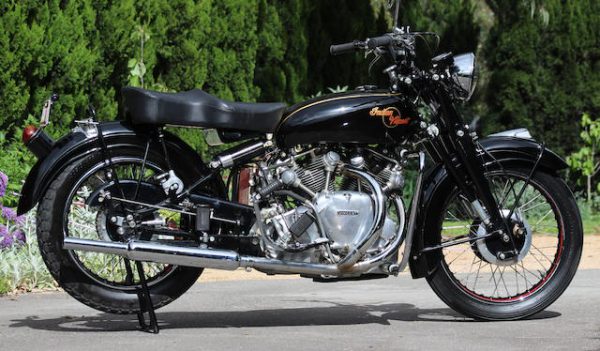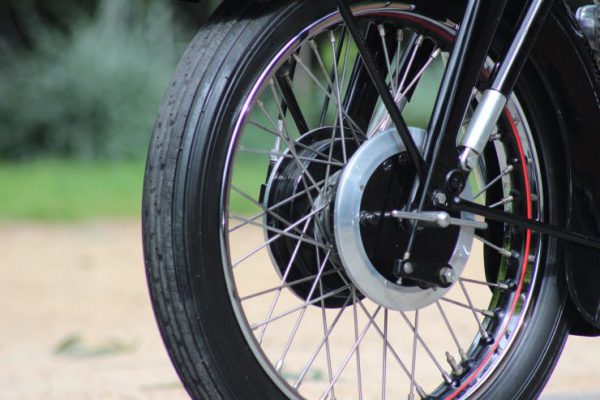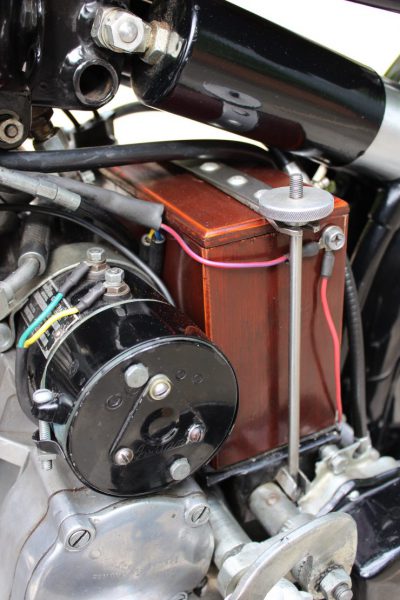Frame no. RC4392
Engine no. F10AB/1/2492
• One of a kind, ultra-rare motorcycle
• Matching numbers example
• Authenticated and recognized by the Vincent Owners Club

The year 1949 was a tumultuous one for the Indian Motocycle Company in Springfield, Massachusetts. The company was beleaguered on several fronts, most entirely due to finances. President of Indian, Ralph Rogers, was envisioning the future of motorcycling belonged to lightweights, like the Japanese manufacturers would confirm in a few short years, but his Torque series motorcycles were six months delayed leading to a loss of income, plus the manufacturing costs were double the estimated costs. Add injury to insult, the British currency was devalued so any advantage of the new lightweights against the English motorcycles was erased.

Rogers invited Phil Vincent of the Vincent Company to visit Indian during his tour of the U.S. dealers where the two men devised a concept to create a blend of the Indian Chief and the Vincent motorcycles. The compromise would have helped Indian with a modernization of the venerable Indian Chief with less investment funds, and also would have helped the Vincent by supplying engines. The plan entailed two prototypes; one would be a Chief with a Vincent engine installed and the second would be a standard Vincent Rapide customized with Indian parts recognizable to the Indian faithful. The proposal would supply 50 units of the former prototype, the Vindian, per week and the delivery of 20 units per week of the latter prototype, the Indian-Vincent. Sounds good on paper but Indian never followed through on the plan following the prototype stage, leading Vincent to enter into receivership due to purchasing materials for the business plan that would never happen.

Vincent engineer, Phil Irving took on the project of the Indian and Vincent combinations. He completed the Vindian project within a month of hard work, fitting the engine from a Vincent Rapide into the 1948 Chief. The bike was road tested and following the necessary photo sessions, the project was dismantled, the Indian put back together and returned to the U.S. The second project entailed the blending of Indian parts to a 1949 Vincent Series C touring Rapide. The Indian-Vincent wore a Delco generator and regulator, a 1940 style fender light, a stock Indian tail light and headlight, an Indian ignition/lighting switch, stoplight switch, dimmer switch and horn. This prototype used a later die cast kick starter cover and timing cover which had Vincent on the cover instead of H.R.D. The rocker covers were also transitional, not bearing the Vincent name. Also mounted were crash bars and western style handlebars to make the motorcycle more receptive to American riders.

Towards the end of 1949, Ralph Rogers resigned as President of Indian due to mounting internal pressures, and in December, Phil Irving also retired from Vincent. Irving was presented with the Indian-Vincent, now stripped of its Indian parts which he mounted his Blacknell sidecar full of this tools and moved to Australia. Irving rode the “Vincent” until 1953 when he traded it for a Vauxhall Wyvern sedan. Then the Vincent disappeared until 2001. It came into the hands of the current owner who started to recognize that certain parts weren’t correct when he learned the true history of this very special motorcycle. Pieces of the motorcycle which had been modified for the fitting of Indian parts still remained, and correspondence with Phil Vincent’s son-in-law confirmed that his Vincent was the actual prototype for the Indian-Vincent. Special stampings and the serial numbers were vindicated in this research.
The owner had to decide how to restore this relic of a motorcycle. Should it be returned as a Vincent and go unrecognized among other Vincents, or should it be restored as the iconic project between two great motorcycle companies? Luckily its history has been preserved as the Indian-Vincent won out. However the project wasn’t simply restoring Indian parts back onto the Vincent. The owner had to fabricate missing parts such as the shift linkage which was on the left hand side of the motorcycle as on the prototype, fighting through the same complications as Phil Irving did back in 1949. It was a monumental effort with spectacular results.
This one-of-a-kind, ultra-rare motorcycle has been beautifully restored and is in operating condition. It has a gorgeous black finish with the Indian-Vincent name proudly on the gas tank, and features all the Indian components as it did back in 1949. The motorcycle has been recognized and authenticated by the Vincent Owners Club. In favor of riding this unique piece of history in today’s world, the electronics have been updated to 12 volts. Its American flavor is immediate with the Western style handlebars.
More pictures on the bike’s page at Bonhams, here.
